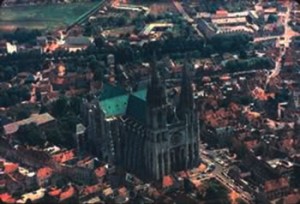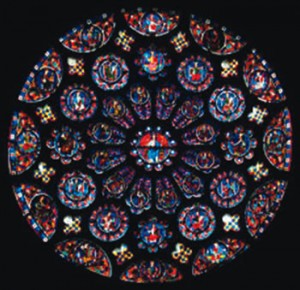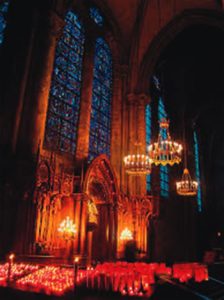A Splendid French Cathedral – Chartres
Chartres Cathedral is known as the Jewel of France – with good reason. It’s long and colourful history began with a deep devotion to our Blessed Mother, a devotion which continues today in the form of thousands of pilgrims visiting every year. Mary’s presence, however, was here long before the present cathedral was built.
By the time the Gothic masterpiece we now see came about in the 12th and 13th centuries, at least five other cathedrals had stood here. Earlier still, the land was believed to be a Druidic ceremonial site and was considered sacred. Legend tells that around 100BC the Druids received a prophesy that a virgin would arrive and give birth to a son who would be a king. A carved, wooden statue of a mother and child was erected and named Matri Futurae Dei Nascaturi – ‘to the Mother of God as yet unborn’ – on the site of the present cathedral. By AD 67 the shrine was known as Notre Dame de Sous Terre (Our Lady of Under the Earth) and was moved to the church which had been built over the grotto.
The statue seen in today’s cathedral is a mid 19th century copy as the original was destroyed during the French Revolution. However, the Notre Dame de Sous Terre is an integral part of Chartres and is thought to be one of the oldest shrines dedicated to Our Lady in the world.
Mary’s influence was reinforced in 876 when her veil, believed to be the one she wore when she gave birth to Christ, was given to the church. The emperor of the Franks, Charlmagne had received the Sancta Camisa from the Byzantine emperor and his wife. Eventually it was passed down to Charlmagne’s grandson Charles the Bald who then donated it to Chartres. The camisa, which today is displayed in a reliquary in the north east chapel, is credited with saving the town twice from Viking and Norman invaders. On the second occasion the Normans fled shortly after the people processed the streets carrying the veil. The townsfolk felt they were divinely protected and as word spread, pilgrimages increased along with the prosperity of Chartres.
Suddenly everyone wanted to be in this little corner of France. A mere 80 km south west of Paris, it attracted tradespeople and scholars, all eager to be part of this community. With so many learned people gathered here, it became one of the most influential towns in the country.
Adversity however, was far from absent. After a fire totally destroyed the church in 1020, rebuilding began, this time in stone. Much of today’s crypt relates back to that time – it was and still is believed to be the largest in France. Building continued into the early 12th century, when by this time, several major feasts in honour of Our Blessed Lady, saw the town swelling considerably with pilgrims. The Purification (2nd February), the Anunciation (25th of March), the Assumption (15th of August) and the Nativity (8th September) attracted multitudes who wished to see the camisa and pray to their Patron.
Another fire in 1134 saw the west end of the cathedral damaged. Repairs and ongoing building 11 years later saw Chartres citizens turn out in force to help. In the 12th and 13th centuries it was not unusual for villages and towns in Europe to unite in constructing important, especially ecclesiastical, buildings. The Cult of the Carts saw ordinary townsfolk dragging carts full of building materials and provisions to the site. “Among them,” according to one report on the Chartres building, “ were lords and ladies, pulling carts with the rest. There was perfect discipline and a most profound silence.”
Yet another fire in 1194 caused substantial damage to the cathedral. Apart from the crypt as previously mentioned, all that remain today of the earlier buildings are some of the stained glass windows, a medieval spire and the Royal Portal on the west front. An almost total reconstruction took place – which may never have happened had the sacred camisa not survived this latest fire.
The devastated people of Chartres, convinced their precious relic had been lost, felt that perhaps they had fell out of favour with the Blessed Virgin. If so, they had no interest in building yet another cathedral. The recovery of the camisa brought relief and a new sense of purpose to the town and in1195 rebuilding began and as before, everyone got involved. Funds began arriving from all over Europe enabling them to build bigger and better than before. The end of the 12th century was a time of dramatic change in architcture; different skills and methods of construction were emerging and Chartres was determined to be at the forefront.
The new cathedral was made of limestone and the sheer scale of the building meant it was the first of its kind to use flying buttresses to support the walls. This structural style also enabled larger than usual windows to be installed; depicted within the magnificent stained glass – again designed specifically for Chartres – is a stunning array of Biblical scenes. Most of the 176 windows are the originals dating from the early 13th century, and unlike earlier models which tended to be plainer or monochromed, rich colours and hues were used which added extra dimensions to the interior of the cathedral.
Aside from their beauty, the windows were designed to inform. Not just stories from the Old and New Testaments and portrayals of various saints, but telling of the tradesmen who worked in an around the town at that time. All manner of occupations from fishmongers and butchers to shoemakers and carpenters are displayed – in fact 42 windows represent the merchants of Chartres in the early 1200s.
Few changes have been made since the cathedral was consecrated on the 24th of October 1260. A small chapel was added in the 15th century, the north spire was replaced in the 16th century after a lightning strike destroyed the original and some minor alterations were made in the 18th century to the interior to enable greater participation in the Mass. The choir screen separating the choir from the nave was removed and replaced with the stalls seen today and some of the clerestory windows had clearer glass installed to brighten the area surrounding the High Altar.
While some damage occurred during the French Revolution, Chartres did not suffer the fate of many ecclesiastical buildings which were destroyed or experienced the loss of precious windows. It also came through World War Two virtually unscathed, so the present day cathedral, despite some restoration over the centuries, remains true to its Gothic roots.
Spiritually however, its roots began with Mary. Driven by a devotion to the Mother of God, the people of Chartres overcame every adversity to bring about the architectural wonder that we see today, the Cathedral Basilica of Our Lady of Chartres.




 Entries(RSS)
Entries(RSS)